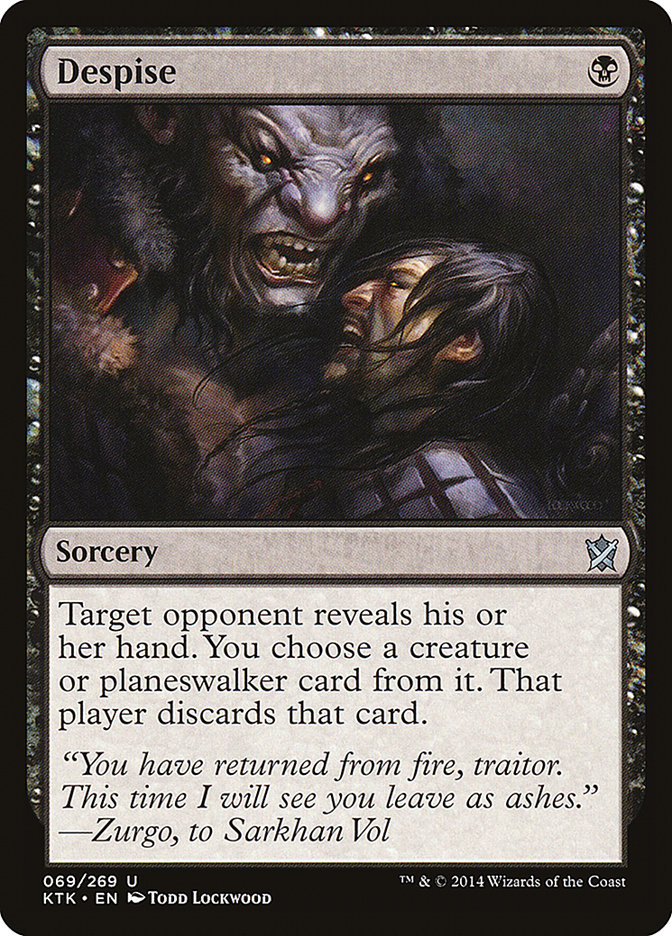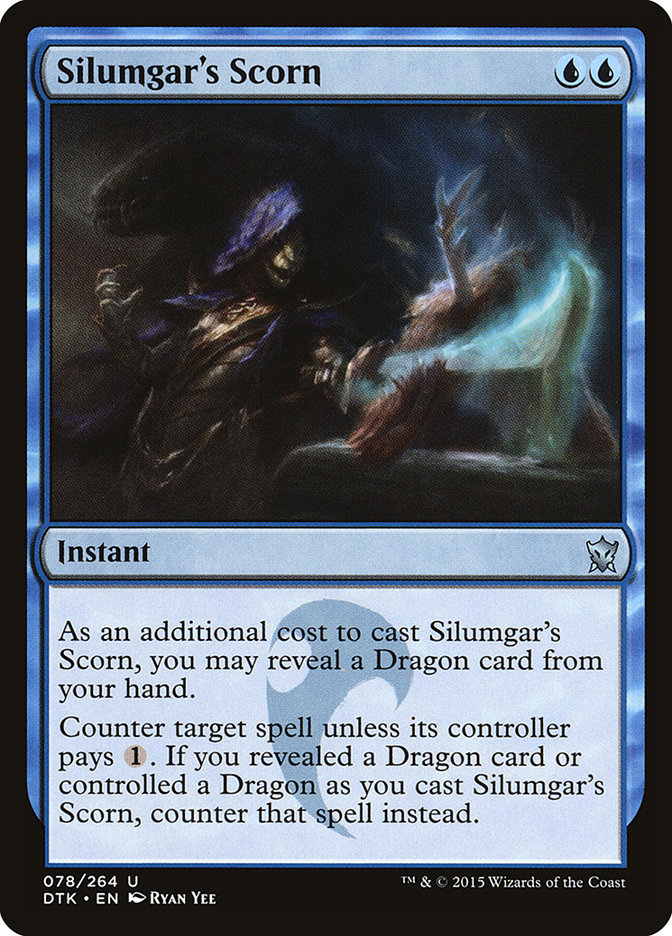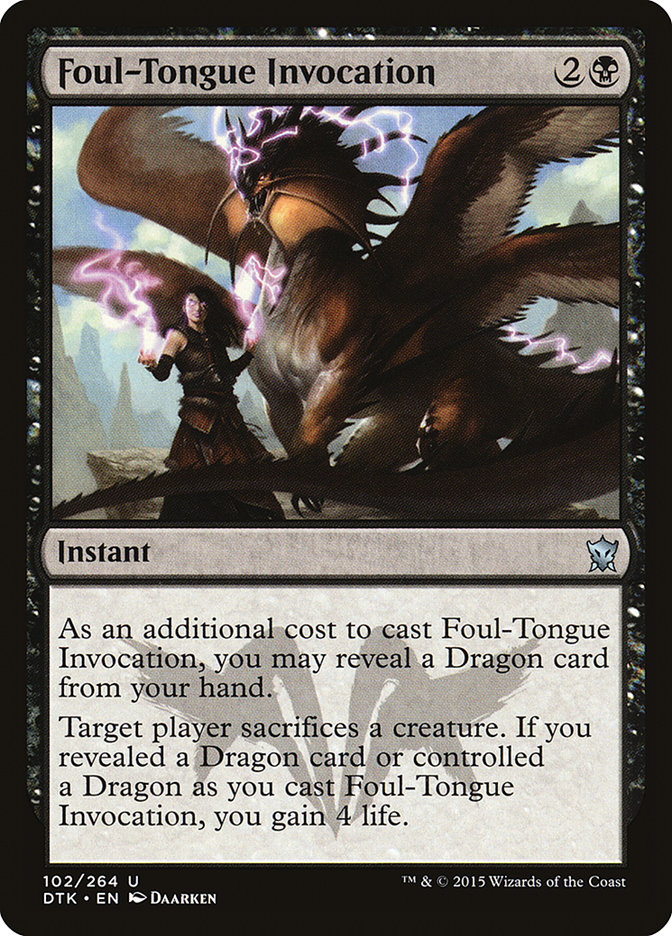Control mages in Standard have a major problem with deckbuilding these days. There are so many good planeswalkers, Dragons, and control spells that picking an avenue to go down is harder than ever. On one hand, we have the most powerful creature win conditions that if left unchecked, can win the game single handedly. I’ve tested and watched match after match where Dragonlord Ojutai comes down protected and leaves when the opponent has conceded. Dragonlord Silumgar is in a similar situation, stealing the most powerful threat on the battlefield with a natural defense against Crackling Doom and cheap removal. With the lack of powerful, instant speed removal, Esper Dragons feels like the deck to beat in Standard, but there are a few planeswalkers that would like to have their say in that debate. The planeswalker version of Esper is powerful as well in a world without Hero’s Downfall and early threats. Silkwrap has been a godsend for the problematic Hangarback Walker and anything else that decides to enter the battlefield before we’ve assembled the planeswalker team. Jace, Vryn’s Prodigy fits perfect in a planeswalker build by flipping prior to Languish entering from above. There are so many reasons to play each control strategy, so I want to give you my tested and most up-to-date lists for each and their pros/cons. I’ve always been able to throw together the best control deck based on the metagame and never look back, but today it’s not that simple. Let’s get to work!
Creatures (5)
Planeswalkers (4)
Lands (27)
Spells (24)

This is the old faithful build of Esper Control that has done me no wrong so far this season. I haven’t been able to play a whole lot of competitive Standard, but the tournaments I made it to have resulted in decent finishes. The deck, like any, has its negative and positive traits that have to be weighed prior to sleeving it up for any level of tournament.
The Pros
This is one of those decks that has too few creatures for opponents to take advantage of before and after sideboard. Having just four Jace, Vryn’s Prodigy and one Fathom Feeder in the maindeck creates a nightmare scenario for a plethora of possible draws an opponent can have. In today’s Standard, players have to pack a ton of creature removal to have a shot at winning a large scale tournament. Creatures are getting better and better, spells are getting worse, and you have to develop your strategy around that truth from here on out. This was one of the major reasons why I was stuck on Despise for so long, but after testing Duress, it’s clear that the removal suite we deploy is robust enough to deal with our opponent’s threats. The ability to have Jace, Vryn’s Prodigy recast also provides huge upside. The matchup where cutting Despise has really hurt is against Eldrazi Ramp, which moves into a more difficult matchup category now.
Having a minimal amount of creatures in the deck with a large amount of removal is a recipe for good matchups against the midrange and control decks out there. Their Silkwraps after Jace, Vryn’s Prodigy has done its thing are worthless and their black removal spells are borderline dead cards. There is so much disdain for Ruinous Path that people have nearly abandoned it completely, but I still think it has a solid place in Esper Control. That leaves Utter End as the only relevant removal spell that can really impact the battlefield once we get rolling. When I see their hand from a Duress and it is a bunch of removal and Siege Rhinos, I feel safe and secure. Esper Control has such resilience to decks that pack the heat; we really just want to avoid the fastest of aggro decks and those using Ulamog, the Ceaseless Hunger.
Another huge advantage to Esper Control over Esper Dragons is the eventuality of victory. Esper Dragons doesn’t just eventually win like Esper Control does. Cards like Crackling Doom, Abzan Charm, Murderous Cut, and others that do similar effects can halt you immediately if you are using the Dragon strategy. With Esper Control there isn’t a card or two that stop the card advantage, repeated threat production, sturdiness, and/or cheap cost of the planeswalkers we employ. Narset Transcendent moves up to seven loyalty, Gideon, Ally of Zendikar provides an immediate threat, Ob Nixilis Reignited draws a card or slays a creature, and Jace, Vryn’s Prodigy is very undercosted. These planeswalkers are easier to protect than creatures are in most cases, which gives a lot of bonus to choosing this strategy over others. There have been suggestions by some to combine the two strategies into one, which sadly isn’t possible. I’ve toyed with a planeswalker or two in the maindeck of Esper Dragons and the result isn’t good. The Dragon’s package contains too many cards that are a must-include, such as the creatures themselves, Silumgar’s Scorn, and Foul-Tongue Invocation. These are the draws to playing Esper Dragons, so the planeswalker count can’t be more than one and is usually zero. This also boils down to playstyle at the end of the day. If you enjoy tapping out even more so then usual, then you jam the Dragons. If you want to slowly, methodically control the battlefield with an eventual victory, then it’s time to employ an array of planeswalkers.
The Cons
The Esper Control strategy is problematically slow. It takes forever to actually deal lethal damage to your opponent if you also desire to play optimally. I’ve seen players very early on jam Shambling Vents into the red zone in order to work on the time element that looms over you during a match of Standard behind the planeswalker strategy. All control decks take longer to play and make optimal decisions with, which is the nature of the game. The decision tree for control is extensive and sadly that gives a lot of limbs and branches that lead to defeat. In order to dodge that outcome, you have to think through your plays well in advance, and this leads to unintentional draws. I’ve been fortunate enough to avoid these so far, but that was mainly due to good guy Phillip Napoli’s concession at the #SCGPHILLY a month ago when time had expired. I was ahead on the battlefield by far, but not every opponent is going to graciously walk away with a loss over a draw when it is clear that your deck is the time culprit. Slow play doesn’t even have to factor in because the cards we use physically chop away at the fifty minute time limit we have to defeat our opponent. So what do you do? Playing at a fast rate early by dropping land and immediately passing, keeping your opponents moving if they are taking an unreasonable amount of time making decisions, and planning your plays out are all strategies I use to avoid unintentional draws. The hardest thing to do is keep your opponents moving, and that is something you simply have to overcome when playing in a big tournament.
Another issue with this deck is the difficulty to pilot. Esper Control, by having a more abstract way of winning than other strategies, is more difficult to pilot by definition. There isn’t a dodge, weave, slam Aetherling, and attack a few times. This is an intricate process that involves a fight for survival with an eventual victory. This means if you play well and pull ahead of your opponent, you’ll easily win in the future, but if you make egregious errors, there is no Dragonlord Ojutai to save you when cast against an opponent without an answer. Gideon, Ally of Zendikar is fantastic, but he’s no Gideon Jura. In the old days, control could easily stabilize with Gideon Jura regardless of issues prior to turn 5, but Gideon, Ally of Zendikar doesn’t have that catch up ability built in. All of these planeswalkers are powerful in their own way; however, none of them help you when significantly behind. Luckily there is an easier to pilot control deck out there that dodges the time pitfall.
Creatures (10)
Lands (27)
Spells (23)

Esper Dragons was my favorite creation in the recent era of Standard, which is the main reason why I feel the need to play it regardless of power level. When Jeskai Black ruled the world, playing a Dragonlord Ojutai deck was too difficult. The naysayers were adamant about the weakness of Crackling Doom after I switched to the planeswalker strategy. They said that Duress and countermagic were the weapons that could push Dragonlord Ojutai through. I still believe they are wrong. The very tools we have at our disposal are the ones that they use as well. When aggressive decks use a combination of threats and blue disruption, our chances of victory plummet. So why should you use Dragons over planeswalkers?
The Pros
Esper Dragons is a much easier deck to pilot, but it also runs smoothly. Running smoothly isn’t an advantage you hear a lot of pros talk about when breaking down a deck, but it definitely applies here. The curve is a thing of beauty in Esper Dragons, because of the four copies of Dragonlord Ojutai being an easy slam dunk at the end. I had versions with less copies, a one-of Ugin, the Spirit Dragon, and other clunky spells; however, this list is streamlined for your convenience. I still have my bullets that can take over a matchup, like the copy of Ojutai’s Command in the maindeck and the other two in the sideboard. For the most part though, this version of Esper Dragons is built in a way that shines a bright light on the avenue for victory. I’ve said time and time again that Magic is a tough game, period. This deck, like many others out there, is built in a way that yields victory with twenty minutes of solid play, instead of fifty. Your opponent can only take so many hits from a Dragon before falling in comparison to the grind of creature-lands and planeswalkers alone. Some competitors steer away from control decks simply because of their difficulty; however, Esper Dragons is one that requires a lot less reps than Esper Control. The matches play out very similarly when testing, the decisions are fewer in number, the win condition is relentless if left unchecked, and the time limit of the round expires less. These listed traits of Esper Dragons give you a window into what “smooth” means in terms of a Magic deck and the way it plays out.
The best perk to playing a Dragon strategy is having access to Silumgar’s Scorn and Foul-Tongue Invocation. Foul-Tongue Invocation lost some power with the printing of Hangarback Walker, but the little artifact sees less and less play these days. When I saw my Abzan opponent play a Snapping Gnarlid on turn 2 for the first time, I almost fainted. If players want to shave down on the number of Hangarback Walkers and get cute with curve-fitting win conditions, then we win at the end of the day. The lifegain on Foul-Tongue Invocation is absurdly powerful. I mentioned months ago that for three mana and four life I could care less what the rest of the card did, but this happens to have very relevant text if you continue reading. The better of the two cards is still Silumgar’s Scorn. Force Spike is still fantastic and Counterspell has Legacy power. The lands actually enter the battlefield untapped more, which makes Silumgar’s Scorn that much better. When I first crafted Esper Dragons, I was only using four copies of the creature type in total, but now with six copies, I always have the advantage. There isn’t a matchup where I don’t want both of these cards. The instant speed removal is great against creature-lands, Dragons, and aggressive creatures. Two mana counterspells will never exit my deck against the fastest of decks to the slowest. Having that many copies of spells that are good against the field is a pretty good pro when determining which deck to pilot.
The Cons
Most of the cons I’ve discussed earlier in the article, but the glaringly obvious one is the creature rule. Winning by way of creature always has its drawbacks, because an opponent can simply one-for-one it and move on. If you are Duressed by a Jeskai Black player and left with an unguarded Dragon as your only play, it usually results in disaster. If your opponent plays one-drop, two-drop, three-drop, and you do not have Languish, the result is an instant loss. Languish and creature win conditions do not mesh, and for that reason you don’t see copies of Dragonlord Ojutai with it. The Esper Dragons lists that do well and my list that was crafted recently from testing don’t contain any copies of Languish, and that opens the flood gates for our aggro opponents to let loose. Languish keeps Abzan and R/G Landfall opponents honest, but when they see that Silumgar’s Scorn they know the coast is clear. The creature rule is applied in this situation, preventing us from playing spells that go against our win condition strategy. I love Crux of Fate in this deck against a medium Abzan start, and it usually does the trick, but against red decks it doesn’t. I was always supportive of Languish in Esper Dragons before, because logically you can cast it on four and play a Dragon on five. Sadly for us it doesn’t work out that well most of the time. The best we can do is stock up on early speed bumps against aggressive decks and gain a ton of life, which has been pretty phenomenal after sideboard. Before sideboarding, however, I have not won more than a game or two against the red menace.
For all of you that read my column regularly you know how I feel about giving up games to red decks, so that was a huge con I took into consideration when choosing which deck to use. At the end of the day I feel that Esper Dragons packs more punch, but Esper Control is more consistent. With harder work, training, chess-like planning in-game, and tight play, Esper Control grants victory more often. For these reasons I’m using the planeswalker strategy for the upcoming #SCGINVI this weekend. If I do poorly, you better believe it’s Dragon time, but I’ve trained too hard to not give my planeswalker posse a shot at glory. Pick a side, play it well, and get some wins for Team Esper my friends!





